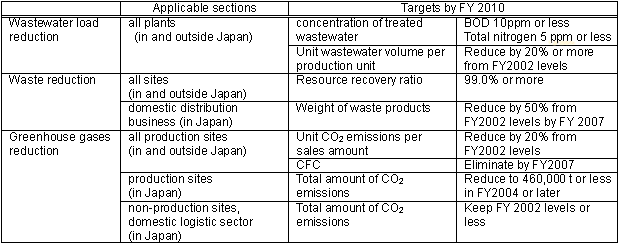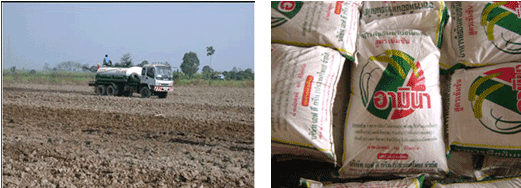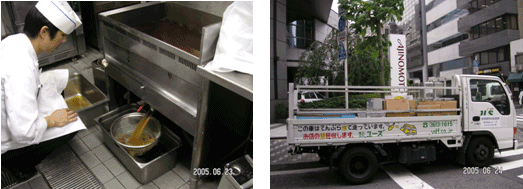

|
2005-2010 Ajinomoto Group Zero Emissions Plan Launches Aiming Toward A Recycling-oriented Society |
|
October 3, 2005 - Tokyo - Ajinomoto Co., Inc. (Ajinomoto, President & CEO: Norio Yamaguchi; Headquarters: Tokyo, Japan) announced its launch of the 2005-2010 Ajinomoto Group Zero Emissions Plan, which was established based on its Corporate Social Responsibility (CSR) policy stated as a core strategy in the Fiscal 2005-2010 Medium- to Long-Term Management Plan. In the 2005-2010 Ajinomoto Group Zero Emissions Plan, the specific targets are set to be achieved in a wide range of areas by fiscal 2010 starting from fiscal 2005. The Group as a whole has already started tackling to minimize any environmental impacts under this plan.
The 2005-2010 Ajinomoto Group Zero Emissions Plan mainly focuses on the following three areas; 1. Zero emissions of waste: to increase the resource recovery ratio up to 99.0 percent or more at all sites. 2. Zero emissions of wastewater load: to decrease the concentration of biochemical oxygen demand (BOD) of treated wastewater to less than 10 ppm and that of total nitrogen to less than 5 ppm at all the production sites. These targets are set ten times as stringent as the world's advanced laws and regulations. 3. CO2 and CFCs reductions: to reduce unit carbon dioxide (CO2) emissions by 20 percent from 2002 levels and eliminate chlorofluorocarbons (CFCs) by fiscal 2007. The followings are the achievements in fiscal 2004 in the areas of reductions of waste, wastewater load, and CO2 emissions, to meet the targets set in the Ajinomoto Group Zero Emissions Plan. 1. Waste reduction: 1) Eight plants in three countries newly achieved "zero waste emissions". Accordingly, 24 plants of seasoning, feed additives, and food products in ten countries in total have achieved "zero waste emissions" so far. 2) The resource recovery ratio increased to 97.8 percent in fiscal 2004, from 93.2 percent in fiscal 2001, 95.0 percent in fiscal 2002, and 96.3 percent in fiscal 2003. 2. Wastewater load reduction: Six plants, two of which are outside Japan, achieved "zero wastewater load emissions" by introducing innovative production process to reduce the amount of wastewater and by developing advanced technologies for wastewater treatment, such as biological denitrification (BDN) treatment method. 3. CO2 emissions reduction: 1) In the fermentation-related production business, which generates about 80 percent of total CO2 emissions of the Group, unit CO2 emissions decreased by about ten percent from the levels in the previous year by increasing production efficiency and introducing energy saving production processes. 2) The domestic logistics business in Japan has promoted modal shift initiatives, and the modal shift ratio increased to 26.3 percent accordingly. Please see our website (URL http://www.ajinomoto.co.jp/company/environment/) for the further details on the achievements of the Group's environmental initiatives in fiscal 2004 as well as the 2005-2010 Ajinomoto Group Zero Emissions Plan. The Ajinomoto Group aims to tackle environmental conservation to play a role to the shift toward a recycling-oriented society with further technological innovation. [Priority Issues in the 2005-2010 Ajinomoto Group Zero Emissions Plan]  [Definition of the Ajinomoto Group "Zero Waste Emissions"] The resource recovery ratio of both by-products and general waste generated from plants and sites should be 99.0 percent or more. The ratio of disposed waste without being recycled, such as those incinerated or landfilled, should be less than 1.0 percent. [Definition of the Ajinomoto Group "Zero Wastewater Load Emissions"] The concentration of BOD5 in wastewater discharged from any plants should be 10 ppm or less and that of total nitrogen should be 5 ppm or less. [Attachment] 24 Plants in Ten Countries Achieves "Zero Waste Emissions"
- Resource Recovery Ratio Improved Up To 97.8% - Ajinomoto Co., Inc. (Ajinomoto, President & CEO: Norio Yamaguchi; Headquarters: Tokyo, Japan) achieved "Zero Waste Emissions" in its eight plants in Peru, Indonesia and Japan in fiscal 2004. Under the Ajinomoto Group Zero Emissions plan, the Group tackles the minimization of any environmental impacts made through all the business activities, and with this new achievement, 24 plants of seasoning, feed additives and food products in ten countries in total now have met the Group's "Zero Waste Emissions" criteria. The Ajinomoto Group endeavors to increase the resource recovery ratio, one of the Group's major environmental goals, to 99.0 percent. In fiscal 2004, the ratio increased to 97.8 percent, from 93.2 percent in fiscal 2001, 95.0 percent in fiscal 2002, and 96.3 percent in fiscal 2003. Particularly, fermentation-related production sector, which generates 93 percent of the Group's total amount of waste including by-products, strives to improve its resource recovery ratio. By utilizing solid or concentrated liquid by-products as compost and feedstuff in cooperation with local farms and sugar and starch factories, as well as by separating general waste thoroughly for recycling, the resource recovery ratio increased to 99.0 percent, accordingly. Furthermore, the Group intends to develop technologies to commercialize high value-added, fermentation by-products through realizing a concept of "100% Product - Zero Waste from Whole Fermentation". Food products business improved its resource recovery ratio with an increase up to 93.9 percent through its efforts, such as composting raw materials residues and recycling them as feed and using wasted cooking oil as fuels for boilers. It continues its efforts for the further improvement. Domestic sales business in Japan successfully achieved to reduce the amount of returned or wasted products in cooperation with client companies such as distributors. Offices are also engaged in efforts to minimize waste, including recycling cooking oil used at a restaurant at the headquarter building for feedstuff, soaps and vegetable diesel fuel (VDF). The Ajinomoto Group promotes further efforts in reduce, reuse and recycling of waste and intends to develop various resource recovery initiatives so that any plants and offices in and outside Japan can achieve "Zero Waste Emissions" by fiscal 2010, by introducing those suitable to respective local conditions as well as to types of waste they generate. [Definition of the Ajinomoto Group "Zero Waste Emissions"] The resource recovery ratio of both by-products and general waste generated from plants and sites should be 99.0 percent or more. The ratio of disposed waste without being recycled, such as those incinerated or landfilled, should be less than 1.0 percent.  By-products from fermentation process, Thailand Liquid fertilizer (left) and organic fertilizer (right)  An initiative at Headquarters Office: recycling used cooking oil from the restaurant Straining used cooking oil (left) and a truck collecting used oil, which uses VDF as fuel (right). |
| CLOSE |